Further to the news that Gordon Moore, co-founder of Intel, died last week, it’s a reminder that also last-week-in-history (22 March 1993), Intel announced it would be shipping its Pentium microprocessor. This was the successor to the Intel 486, and it was a massive undertaking that involved thousands of engineers and scientists, and it took several years to complete. These first Pentium chips had a clock speed of 60 MHz, which was considered very fast at the time (despite modern clock speeds being several GigaHertz).
This perfectly illustrates Moore’s Law (i.e. the doubling of chip/components every year), which was observed by Gordon Moore himself back in 1965. For example, here’s one way they’ve grown in power, from 1971 (when Intel introduced the world’s first microprocessor, the Intel 4004) to 2021.
Year / FLOPS (Floating Point Operations per Second)
1971 700,000
1981 5,000,000
1991 1,900,000,000
2001 7,200,000,000,000
2011 8,200,000,000,000,000
2021 442,000,000,000,000,000
According to this, the fastest computer in the world in 2021 was 631,428,571,429 times more powerful than that in 1971. To be clear, FLOPS don’t show true processing power and Moore’s Law has been slowing down and many other factors apply; this exercise is purely for a sense of comparison and awe.
Humans brains aren’t great at scale (i.e. very small or large numbers) so for perspective, if one were to imagine that a single sheet of A4 paper (80 GSM standard office paper) represents a supercomputer in 1971. On that piece of paper, you coiuld write on it, draw on it, do sums on it, whatever you like.
In 2021, the computer would be represented by 631,428,571,429 sheets of A4. That’s 39 billion square metres or enough office paper to wrap over all of Wales TWICE over.
In short, as computers are getting more powerful, crunching passwords take less and less time – exponentially so. Furthermore, computers are now connected more than ever before and platforms (and associated AI’s like ChatGPT) are getting more powerful, exponentially. Think about next year!
In summary, Moore’s Law is a form of compound growth, the eighth wonder of the world, according to Einstein.





